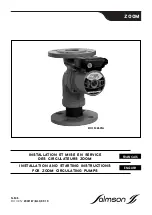
107
Check that the filter is appropriate for the purpose – check colour code, letter code and class.
Before initial use, always check that the product is within the stated shelf life (use by date).
ASSEMBLY INSTRUCTIONS
1 Filter/facepiece assembly instructions
a) Align 6000 Series filter notch with facepiece mark and push together (fig 2).
b) Turn filter 1/4 turn clockwise to stop (fig 2).
2 Discard and replace both filters at the same time. Ensure that both filters are of the same type and class
3 Replace the filter if taste, smell or irritation from gases or vapours is noted or if any part of the indicator bar reaches the
end-of-service line (denoted by rubbish bin icon on filter label). The service life of chemical filters will depend upon the activity
of the wearer (breathing rate); the specific type, volatility and concentration of the contaminants; and environmental conditions
such as humidity and temperature.
To remove filter turn 1/4 turn anticlockwise.
HOW TO CHECK THAT THE 6051I/6055I IS APPROPRIATE FOR THE PURPOSE.
To use the ESLI properly, it is critical that the user or safety manager:-
1 determines whether or not the ESLI is appropriate for the organic vapours in their environment
2 is able to read and interpret the ESLI
3 checks the ESLI regularly, and
4 replaces the filter as necessary
If these steps are not followed, do not rely solely on the ESLI to determine a filter change schedule. Instead, the ESLI may be
used to augment your current filter change schedule, i.e., change filter according to established filter change schedule, or
according to ESLI; whichever occurs first. Please contact 3M for advice on how to establish a filter change schedule. If the
ESLI is not being relied upon, do not use for respiratory protection against atmospheric contaminants/concentrations which
have poor warning properties
Detectable Compounds
The ESLI is only appropriate for certain organic vapours and exposure concentrations. The vapour concentration moving
through the filter that causes a noticeable change in the indicator is called the minimum indication level (MIL). The MIL is
different for each organic vapour.
Prior to use, airborne contaminants in the work environment must be identified and quantified.
The applicability of the ESLI must be determined for all potential use scenarios, including both low and high exposure levels.
The ESLI is only recommended if both of the following are true:
1 MIL
occupational exposure standard for all intended applications (indicator bar will develop before vapour concentration
moving through filter reaches exposure limit), and
2 Worker exposure levels
MIL (exposure concentration is high enough to cause noticeable change in indicator).
Example:
MIL = 1 ppm, OEL = 25 ppm, worker exposure = 5 ppm.
MIL (1) ppm is
OEL (25 ppm), AND
Worker exposure (5 ppm) is
MIL (1 ppm), ESLI is recommended.
A list of the MIL’s for common compounds can be found in the reference leaflet.
NOTE This is NOT a list of what the 6051i and 6055i may be used for.
In order to rely on the 3MTM Service Life Indicator as a primary method for determining when to change filters, both of the
above conditions must be met
Exposure Standards are published on certain Government websites. They can also be found on the Material safety data
sheet (MSDS) of contaminants. Certain Exposure Standards are also listed in the 3M Respirator Selection Software which
may be found at www.3m.com/au/ppesafety (Aust) or www.3m.com/nz/ppesafety (NZ).
Do not rely on the ESLI if you do not know the MILs for the specific organic vapours in your workplace.
Mixtures
In order for the ESLI to be recommended for a mixture of organic vapours, the ESLI must be recommended for the individual
organic vapour with shortest service life. To calculate service life and to determine if the ESLI is appropriate for organic vapour
mixtures in your workplace, please see the 3M™ Select and Service Life Software at www.3m.com/au/ppesafety (Aust) or
www.3m.com/nz/ppesafety (NZ) or contact 3M Australia 1800 024 464, 3M New Zealand 0800 364 357.
Reading the ESLI.
The ESLI is covered by a repositionable tab to protect it from overspray and debris.
Prior to using the filter, pull back the tab to view the ESLI.
Ensure that ESLI is intact and uniform in appearance. If the ESLI becomes obscured, gently wipe cartridge area above ESLI
with dry cloth or mild soap and water solution to remove overspray or other residue.
Do not clean the ESLI window with solvents as this may damage cartridge body and make it difficult to see the ESLI. The tab
may be repositioned over the ESLI to protect it until the next viewing.
Do not rely on ESLI if it becomes obscured or hard to read.
The indicator bar may be green on a red background or red on a green background depending on the viewing angle.
Rotate the filter slightly while looking at the indicator.
The intensity of the indicator bar may vary depending on the viewing angle and light level the organic vapour and exposure
levels.
If any part of the indicator bar reaches the end-of-service line (denoted by the rubbish bin icon on filter label), you must leave
the contaminated area immediately and replace both filters.
At very high vapour concentrations, portions of the indicator bar may shift back towards the original colour.
Rotate the filter to a different viewing angle to clearly see progression of the indicator bar. The filter must be replaced when
any part of indicator bar reaches the end-of-service line.
^
WARNING It is critical to be able to see the ESLI and distinguish the indicator bar. If this cannot be achieved, do not
rely on the ESLI. Instead, replace filters in accordance with an established change schedule.
mmm34-8721-7859-4_Part1 14.14.22.pdf 109
12/12/2017 14:20





































